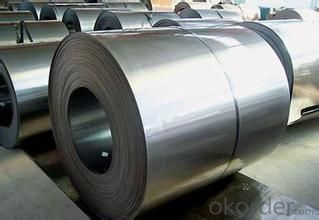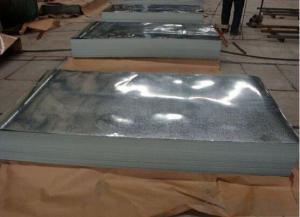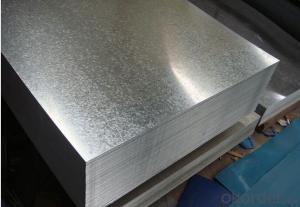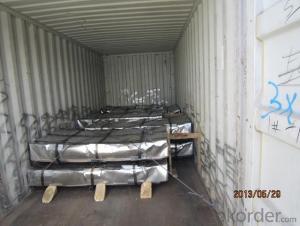High Quality of Cold Rolled Steel Sheet from China
- Loading Port:
- Shanghai
- Payment Terms:
- TT OR LC
- Min Order Qty:
- 100 m.t.
- Supply Capability:
- 5000 m.t./month
OKorder Service Pledge
OKorder Financial Service
You Might Also Like
1.Structure of Cold Rolled Steel Description:
The raw material of cold rolled steel coil/sheet is high quality hot rolled product, and after pickling continuous rolling, degreasing, annealing,skin pass,slitting and cut to length line etc. Along with it many kinds of new technology and new process of global cold rolling production have been applied. Therefore the quality of the goods could be guaranteed. The product is widely used in outdoor and interior decoration, furnishing manufacturing, home appliance, automobile etc.
2.Main Features of the Cold Rolled Steel:
• Excellent process capability
• Smooth and flat surface
• Workability, durability
• Excellent heat resistance performance
• High strength
• Good formability
• Good visual effect
3.Cold Rolled Steel Images

4.Cold Rolled Steel Specification
Standard:AISI,ASTM,DIN,GB,JIS,JIS G3302 ASTM 653M EN10142
Grade: Q195~Q345
Thickness: 0.16mm~1.5mm,0.16-1.5mm
Width: 1250,600-1250mm
Coil weight:3-12 MT
Coil ID:508/610mm
Chemical composition:
C | Si | Mn | Cr | Ni | P | S |
0.150 | 0.476 | 11.231 | 12.50 | 0.900 | 0.039 | 0.010
|
5.FAQ of Cold Rolled Steel
We have organized several common questions for our clients,may help you sincerely:
1.How about your company?
A world class manufacturer & supplier of castings forging in carbon steel and alloy steel,is one of the large-scale professional investment casting production bases in China,consisting of both casting foundry forging and machining factory. Annually more than 8000 tons Precision casting and forging parts are exported to markets in Europe,America and Japan. OEM casting and forging service available according to customer’s requirements.
2.How to guarantee the quality of the products?
We have established the international advanced quality management system,every link from raw material to final product we have strict quality test;We resolutely put an end to unqualified products flowing into the market. At the same time, we will provide necessary follow-up service assurance.
3. How long can we receive the product after purchase?
Usually within thirty working days after receiving buyer’s advance payment or LC. We will arrange the factory manufacturing as soon as possible. The cargo readiness usually takes 15-25 days, but the shipment will depend on the vessel situation.
- Q:What are the applications of steel sheets in construction?
- Due to their exceptional strength, durability, and versatility, steel sheets find a wide range of applications in the construction industry. Some of the key uses of steel sheets in construction are: 1. Roofing and cladding: Steel sheets are commonly employed in both residential and commercial buildings for roofing and cladding purposes. They offer a long-lasting and weather-resistant solution, safeguarding the structure against the elements. 2. Structural components: Steel sheets are utilized to construct beams, columns, and trusses, which are essential structural components. The high strength-to-weight ratio of steel enables the creation of lightweight yet robust structures capable of withstanding heavy loads and seismic forces. 3. Flooring: In industrial buildings, warehouses, and factories, steel sheets are often used as flooring material. Their smooth surface facilitates easy cleaning and maintenance, and their strength and fire-resistant properties ensure a safe working environment. 4. Wall partitions: Steel sheets are commonly used in the construction of wall partitions due to their stability and sound insulation properties. They can be easily cut and shaped to fit any design, allowing for flexible and customizable partition layouts. 5. Ductwork and HVAC systems: Steel sheets find extensive use in the fabrication of ductwork and HVAC systems. Their smooth and airtight surfaces enable efficient air movement and regulation, ensuring proper ventilation and temperature control in buildings. 6. Reinforcement: Steel sheets are frequently integrated into concrete structures as reinforcement. This enhances the strength and load-bearing capacity of the building, making it more resistant to bending, tension, and compression forces. 7. Safety and security: Steel sheets are utilized in the construction of safety and security features such as doors, gates, and window frames. Their high strength and resistance to impact and vandalism make them an ideal choice for ensuring the safety and protection of a building. In conclusion, steel sheets play a crucial role in construction for various applications, including roofing, cladding, structural components, flooring, wall partitions, ductwork, reinforcement, and safety features. Their superior strength, durability, and versatility make them an indispensable component in different construction projects, contributing to the overall safety, longevity, and functionality of buildings.
- Q:What are the weight considerations for steel sheets?
- Weight considerations for steel sheets vary depending on the specific application and desired outcomes. Here are a few key points to consider: 1. Thickness: The thickness of a steel sheet greatly affects its weight. Thicker sheets generally weigh more, while thinner sheets weigh less. It is important to choose a thickness that meets the structural requirements of the project while considering weight limitations. 2. Strength requirements: Different applications require steel sheets of varying strength levels. High-strength steel sheets are often thicker and heavier, while lower strength sheets can be thinner and lighter. Understanding the strength requirements of the project is crucial in determining the appropriate weight of the steel sheets. 3. Transportation and handling: The weight of steel sheets impacts their ease of transportation and handling. Heavier sheets require more labor and equipment for lifting, loading, and unloading. Moreover, transport vehicles have weight limits that need to be considered when selecting steel sheet sizes. 4. Structural limitations: The weight of steel sheets can affect the overall structural design. In some cases, lighter sheets may be preferred to reduce the load on supporting structures. However, in other scenarios, heavier sheets may be necessary to provide the required strength and stability. 5. Cost considerations: The weight of steel sheets can also impact the overall cost of a project. Heavier sheets typically cost more due to the increased material required and the additional handling expenses. Therefore, it is essential to strike a balance between weight, cost, and performance to optimize the project's budget. Overall, weight considerations for steel sheets are crucial in determining the appropriate thickness, strength, transportation requirements, structural design, and cost-effectiveness of a project. By carefully evaluating these factors, one can select steel sheets that meet the specific needs while ensuring the optimal weight for the desired outcome.
- Q:What is the average thickness tolerance for steel sheets?
- The average thickness tolerance for steel sheets can vary depending on the specific grade and manufacturing process. However, in general, the industry standard tolerance for cold-rolled steel sheets is ±0.005 inches (0.13 mm) for sheets up to 36 inches wide, and ±0.010 inches (0.25 mm) for sheets over 36 inches wide. For hot-rolled steel sheets, the average tolerance is typically higher, ranging from ±0.010 inches to ±0.060 inches (0.25 mm to 1.52 mm) depending on the thickness and width of the sheet. It is important to note that these are average values, and manufacturers may have their own specific tolerances based on customer requirements and production capabilities.
- Q:Are steel sheets suitable for architectural roofing?
- Architectural roofing can benefit greatly from the use of steel sheets. This material is known for its exceptional durability and longevity, making it an ideal option for such applications. Steel sheets possess impressive strength, enabling them to withstand even the harshest weather conditions like heavy rain, snow, and strong winds. They also offer an additional layer of safety as they are resistant to fire. Another advantage is that steel sheets are lightweight, which makes them easier to install and reduces the burden on the structure. Additionally, architects can choose from a wide range of colors and finishes to achieve the desired aesthetic appearance for the building. In summary, steel sheets are an excellent choice for architectural roofing due to their numerous advantages, making them suitable for both residential and commercial projects.
- Q:How thick are steel sheets typically?
- Steel sheets can vary in thickness depending on their intended use, but they typically range from 0.5 to 6 millimeters thick.
- Q:Are steel sheets suitable for HVAC systems?
- Certainly, HVAC systems can make use of steel sheets. Steel sheets are extensively employed in HVAC systems owing to their durability, strength, and corrosion resistance. They contribute to the structural integrity of the system and can endure high temperatures and pressure. Furthermore, steel sheets can be conveniently fabricated and tailored to meet specific requirements of the HVAC system. In addition, they are cost-efficient and have a prolonged lifespan, making them a favored option for components like ductwork, ventilation systems, and air handling units within HVAC systems.
- Q:What is the average bending radius for steel sheets?
- The bending radius of steel sheets is subject to variation depending on factors such as thickness, grade, and steel type. Nevertheless, in the case of mild steel sheets, the minimum bending radius typically equates to roughly four times the sheet thickness. To illustrate, if the sheet thickness measures 1.6mm, the minimum bending radius would be approximately 6.4mm. It is crucial to recognize that this serves as a general principle, and particular bending specifications may deviate depending on the intended application and desired result.
- Q:Are the steel sheets suitable for welding or fabrication purposes?
- Yes, the steel sheets are suitable for welding or fabrication purposes.
- Q:What is the average moisture resistance of steel sheets?
- The average moisture resistance of steel sheets can vary depending on various factors such as the type of steel, the coating or treatment applied, and the specific environmental conditions. However, steel sheets are generally known to have good moisture resistance due to their inherent corrosion-resistant properties.
- Q:What is the process of etching or engraving on steel sheets?
- The process of etching or engraving on steel sheets involves using various techniques to create designs or patterns on the surface of the steel. Typically, a design is either etched or engraved onto a protective coating applied on the steel sheet using chemicals, tools, or lasers. The protective coating is then removed, revealing the etched or engraved design on the steel surface. This process is commonly used in industries such as manufacturing, jewelry making, and metal art.
1. Manufacturer Overview |
|
|---|---|
| Location | |
| Year Established | |
| Annual Output Value | |
| Main Markets | |
| Company Certifications | |
2. Manufacturer Certificates |
|
|---|---|
| a) Certification Name | |
| Range | |
| Reference | |
| Validity Period | |
3. Manufacturer Capability |
|
|---|---|
| a)Trade Capacity | |
| Nearest Port | |
| Export Percentage | |
| No.of Employees in Trade Department | |
| Language Spoken: | |
| b)Factory Information | |
| Factory Size: | |
| No. of Production Lines | |
| Contract Manufacturing | |
| Product Price Range | |
Send your message to us
High Quality of Cold Rolled Steel Sheet from China
- Loading Port:
- Shanghai
- Payment Terms:
- TT OR LC
- Min Order Qty:
- 100 m.t.
- Supply Capability:
- 5000 m.t./month
OKorder Service Pledge
OKorder Financial Service
Similar products
New products
Hot products
Hot Searches
Related keywords






























